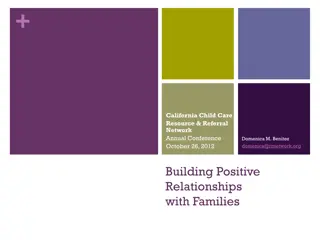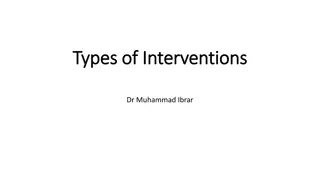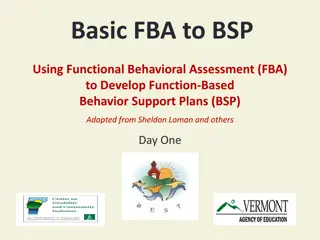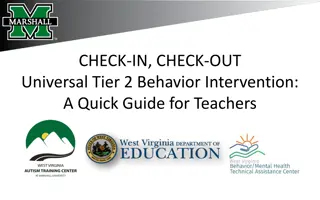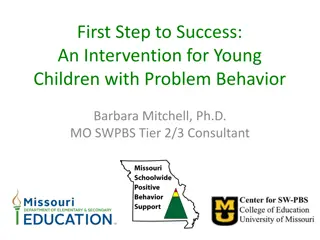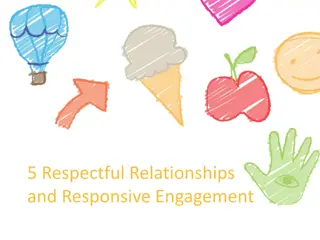Culturally Responsive Behavior Intervention Plans Webinar Series
This webinar series explores the significance of culturally responsive evidence-based behavior intervention plans for students, especially those from historically marginalized groups. It addresses the impact of exclusionary discipline practices, provides insights on functional behavior assessment (FBA) practices, behavior intervention plans (BIPs), trauma, family collaboration, and early childhood. The sessions are designed to enhance understanding and implementation of culturally responsive interventions in educational settings.
Download Presentation

Please find below an Image/Link to download the presentation.
The content on the website is provided AS IS for your information and personal use only. It may not be sold, licensed, or shared on other websites without obtaining consent from the author. Download presentation by click this link. If you encounter any issues during the download, it is possible that the publisher has removed the file from their server.
E N D
Presentation Transcript
Culturally Responsive Behavior Intervention Plans Louise M. Yoho, PhD Behavior Assessment Training Program Southern Illinois University
In this webinar will examine what it means for to have culturally responsive evidence-based behavior intervention plans Welcome! Guest speaker: Mr. Travis Clayton
Who are you? Who are you? Special Education Teacher General Education Teacher Related Services Professional Administrator Other
The Behavior Assessment Training (BAT) project provides professional webinars by content experts on implicit bias, culturally responsive functional behavior assessment (FBA) practices, behavior intervention plans (BIPs), the impact of trauma and other adverse circumstances, family collaboration and early childhood. This project is funded by the Illinois State Board of Education through an IDEA Part B Federal Grant. About the BAT project
Students from historically marginalized groups are more likely than their peers to be affected by exclusionary discipline practices, like suspensions and expulsions. Too often educators view student behavior as a problem, instead of the communication that it is. Importance Importance of topic of topic Culturally, linguistically, and racially diverse children and youth with disabilities make up a disproportionate percentage of students who receive punitive, restrictive, and often exclusionary disciplinary actions.
BAT webinar schedule Upcoming Webinars Archived Webinars May 17th Expanding on major behavior management themes August 9 Restorative Practices September 20 Staff, Community & Family Collaboration October 18 Impact of Trauma and Other Adverse Circumstances November 15 Significant Behavior Needs January 17 Court Involved Youth February 21 Culturally Responsive Data Collection March 20 Implementation Fidelity April 17 Summary and General Follow-Up May 15 Early Childhood October (archived) Teacher Bias & Stereotype Awareness November (archived) Evaluation & Bias December (archived) Legal/Ethical Requirements of FBAs and BIPs January 18th(archived) Viewing student behavior through an action plan February 15th(archived) Culturally Responsive Evidence-Based Behavior Interventions March 15th(archived) Culturally Responsive Evidence-Based FBAs April 19th(archived) Culturally Responsive Evidence-Based BIPs
Culturally Relevant Pedagogy (CRP) Culturally Relevant Pedagogy (CRP) by Gloria Ladson-Billings (1994): is "a pedagogy of opposition specifically committed to collective, not merely individual, empowerment. Culturally Responsive Teaching (CRT) Culturally Responsive Teaching (CRT) by Geneva Gay (2000) is used to describe "using the cultural characteristics, experiences, and perspectives of ethnically diverse students as conduits for teaching them more effectively."
Plan ahead It is important that educators focus on being proactive instead of simply reactive
Map The FBA is your roadmap
Antecedent What comes directly before the behavior Behavior Consequence Reinforcement What comes right after the behavior Negative Positive
Antecedents When, where, and with whom does the problem behavior occur? What circumstances, situations, or activities lead to the problem behavior? Are there emotional or behavioral predictors of the problem behavior? Is the problem behavior related to medication, medical condition, pain, discomfort, problems with sleep, other biological factors, or other setting events?
Clearly defined behaviors Operationally defined What does the behavior sound like? What does the behavior look like? What does the behavior feel like?
Hypothesized need (function) is being Hypothesized need (function) is being communicated? communicated? Attention Seeking Communication of needs and wants Seeking escape or avoidance Difficult task, unfavorable setting, physical discomfort or pain, peer or staff ridicule, showing vulnerability or inability to do a task. Sensory feedback Blindisms, earache, sinus pain, skin irritation, hunger, constipation, fatigue
Ask Yourself. Does the student understand the behavioral expectations for the situation? Is the student aware he or she is engaging in the behavior, or is it a "habit"? Is the student physically and/or cognitively capable of controlling the behavior, or does he or she need support? Does the student have the skills necessary to perform new behaviors?
What do you want the student to do instead? Would this desirable behavior fulfill the same need/function? Is the student capable of engaging in the replacement behavior? Alternative behaviors What prevents this behavior from occurring now?
Summary of Previous Interventions Attempted What has been tried in the past? What were the outcomes? What does that data tell us about reinforcement preferences? What does that data tell us about the match between the hypothesized function and proposed replacement behaviors? Be specific!
What is one thing that you struggle with when implanting a BIP? The function of the BIP doesn t align with the FBA. Lack of specific teaching strategies/interventions Deciding if it is a performance vs skill deficit Data collection issues BIPs are not individualized to specific student.
Mr. Clayton discusses culturally responsive evidence-based behavior intervention plans
How do you and your team utilize the data collected through the FBA process to build the BIP that follows?
How do you identify and teach replacement behaviors? (Such that they serve the same function as the behavior identified as problematic)
What role does cultural responsiveness play in the development of an BIP?
What is the one big take-away you want educators to understand about culturally responsive evidence-based behavior intervention plans?
BAT webinar schedule May 17th Expanding on major behavior management themes August 9 Restorative Practices September 20 Staff, Community & Family Collaboration October 18 Impact of Trauma and Other Adverse Circumstances November 15 Significant Behavior Needs January 17 Court Involved Youth February 21 Culturally Responsive Data Collection March 20 Implementation Fidelity April 17 Summary and General Follow-Up May 15 Early Childhood
EXIT SURVEY EXIT SURVEY
Thank you for your participation! This project is funded by the Illinois State Board of Education through an IDEA Part B Federal Grant.


